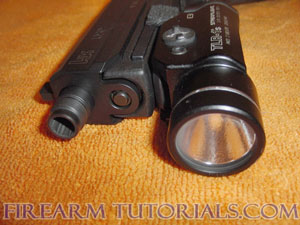Buying a weapon light
There are many different kinds of weapon lights out there. How does one go about choosing which one to buy? Well, there are several steps to go through, but in the end you need to buy a quality product. I can only imagine how much money is spent each year on knock-off or poor quality weapon lights.
If you are buying a weapon light, there are several things to consider:
Number one is very important. Do not buy a cheap light and mount it to a shotgun. The recoil will almost certainly break light will not work. Cheap lights are fine for something like .22 caliber where there is next to no felt recoil. The intensity or overall brightness is measured in lumens. You may see some rated with “candlepower” but lumens is what you should compare all weapon lights against. Anything over 100 lumens is going to be well suited for both indoor or outdoor use.
When using a light over 250 lumens, you must be very careful while using it indoors. Flashing a 300 lumen light onto a white wall will bounce back severely, and possible blind the shooter. Bulb types are important as well. Incandescent lights have a traditional bulb that will shine a fairly “yellow” light. Think of the old headlights used in cars before the xeon lamps. In contrast, LED lights will shine a “white” light. They have better battery life, and will put out more lumens than incandescent.
All quality weapon lights will be at least water resistant and better ones are submersible. Some may be rated to go deeper than others but the best weapon lights are submersible to around 33 feet. Although, the rating is provided in depth and duration in minutes. Check each product rating for specifics. Construction is also important based on how and what weapon it will be used with. Some lights are specific for rifle use as their mounts will not work with handguns. Weight and button placement also exclude them from use on a pistol.
Construction is also important based on how and what weapon it will be used with. Some lights are specific for rifle use as their mounts will not work with handguns. Weight and button placement also exclude them from use on a pistol.
Some lights are designed primarily for pistol use, but because of their compact size and weight are also outfitted on shotguns and assault rifles. Some models can have tap switches attached for easy activation. Depending on the intended use, tap switches may be a bad idea. While they are convenient, they also allow for shooters to give away their positions if accidentally activated.
The lights below are commonly used on both pistols and rifles. They are all good products that will hold up under harsh conditions and to weapon recoil.












- Caliber of weapon
- Rating of light intensity (measured in lumens)
- Bulb type
- Construction/light activation
Number one is very important. Do not buy a cheap light and mount it to a shotgun. The recoil will almost certainly break light will not work. Cheap lights are fine for something like .22 caliber where there is next to no felt recoil. The intensity or overall brightness is measured in lumens. You may see some rated with “candlepower” but lumens is what you should compare all weapon lights against. Anything over 100 lumens is going to be well suited for both indoor or outdoor use.
When using a light over 250 lumens, you must be very careful while using it indoors. Flashing a 300 lumen light onto a white wall will bounce back severely, and possible blind the shooter. Bulb types are important as well. Incandescent lights have a traditional bulb that will shine a fairly “yellow” light. Think of the old headlights used in cars before the xeon lamps. In contrast, LED lights will shine a “white” light. They have better battery life, and will put out more lumens than incandescent.
All quality weapon lights will be at least water resistant and better ones are submersible. Some may be rated to go deeper than others but the best weapon lights are submersible to around 33 feet. Although, the rating is provided in depth and duration in minutes. Check each product rating for specifics.
 Construction is also important based on how and what weapon it will be used with. Some lights are specific for rifle use as their mounts will not work with handguns. Weight and button placement also exclude them from use on a pistol.
Construction is also important based on how and what weapon it will be used with. Some lights are specific for rifle use as their mounts will not work with handguns. Weight and button placement also exclude them from use on a pistol.
Some lights are designed primarily for pistol use, but because of their compact size and weight are also outfitted on shotguns and assault rifles. Some models can have tap switches attached for easy activation. Depending on the intended use, tap switches may be a bad idea. While they are convenient, they also allow for shooters to give away their positions if accidentally activated.
The lights below are commonly used on both pistols and rifles. They are all good products that will hold up under harsh conditions and to weapon recoil.






 07/18/12 02:58:00 pm,
07/18/12 02:58:00 pm,